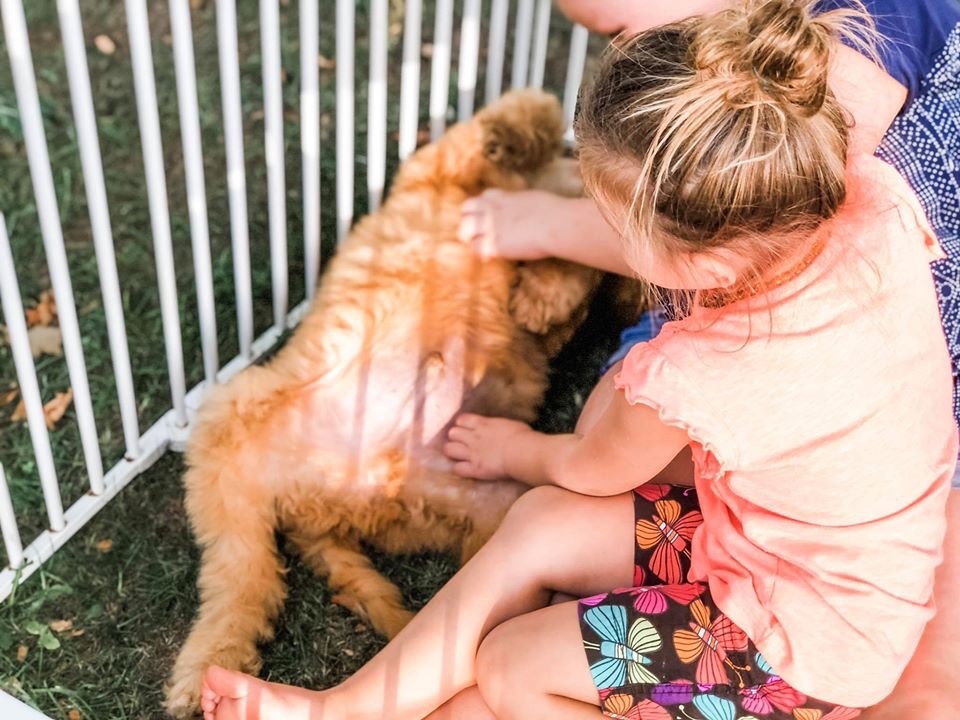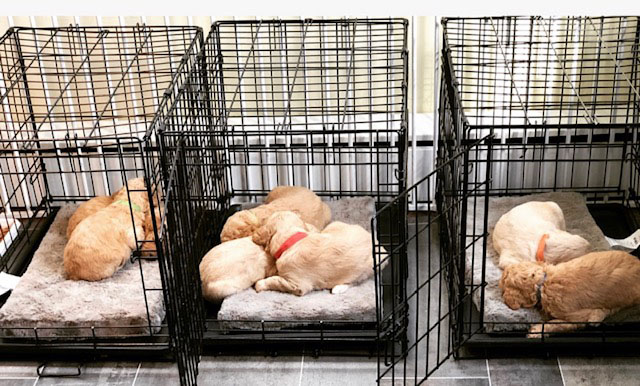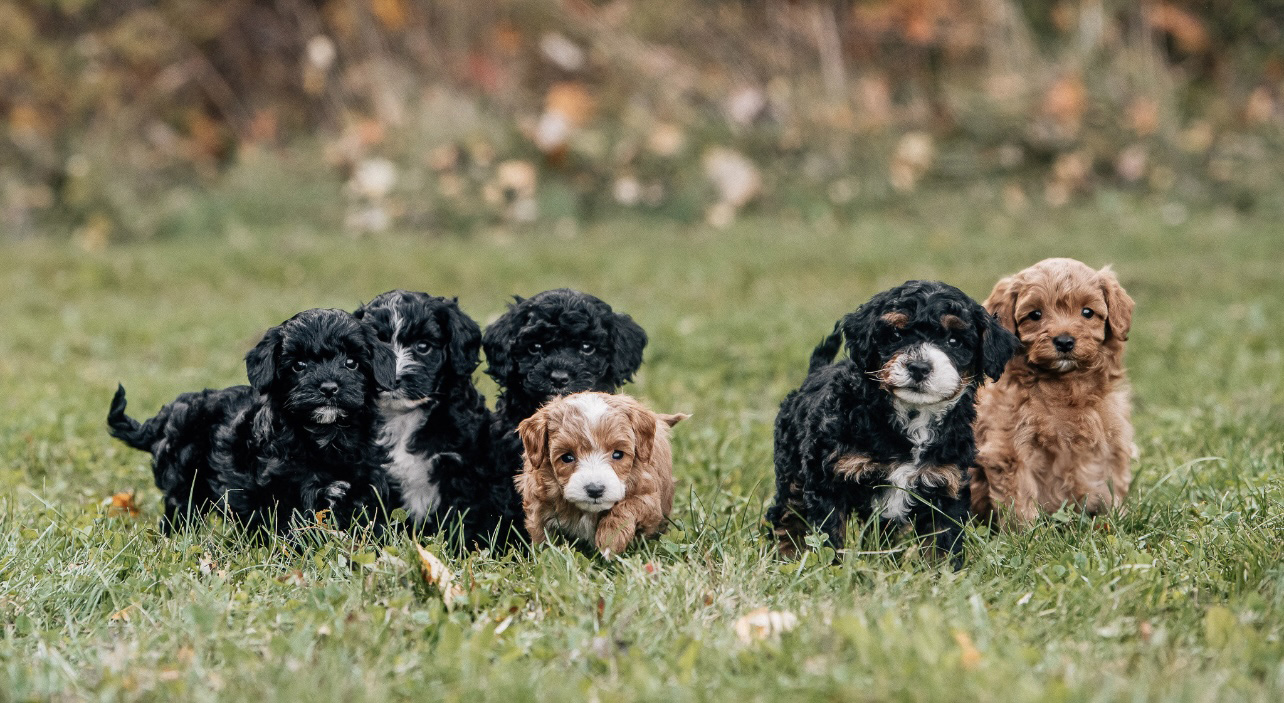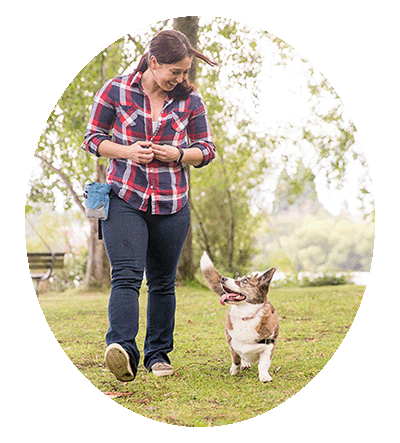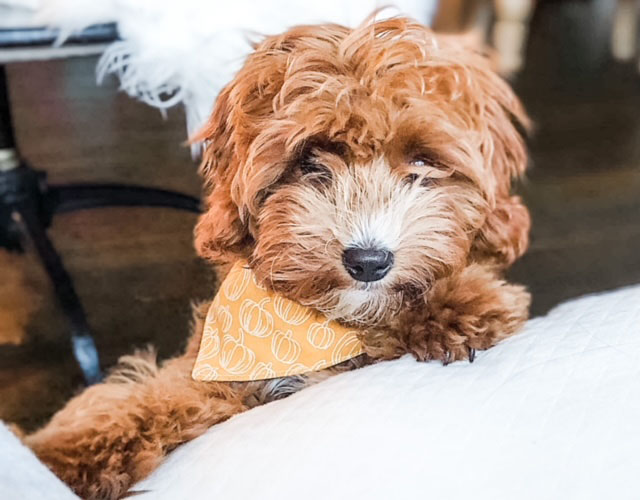How to Crate Train Your Puppy in 4 Easy Steps
When you pick up little Juliet from Maple Hill Doodles, most likely knowing how to crate train her is the furthest thing from your mind. She’s so little and wiggly and cuddly, and you want to keep her safe on your lap all the way home. But you know that once you get home, Juliet is going to need her own secure place. Dogs are den animals, and need a place to curl up, whether for safety, peace and quiet, or sleep.
In an earlier post, we shared many reasons Why to Crate Train Your Puppy. Now we’ll guide you through 4 easy steps to get the job done, gradually and painlessly. Very gradually, actually. Puppies have the attention span of a mosquito!
Get your puppy used to being in the crate
The basics of this first step have been done for you by our family at Maple Hill, so reinforcing it should be easy. That’s why we always include your puppy’s baby blanket with the mama’s scent on it. Little Juliet will be able to snuggle up and be comforted, especially in the first days of living in your home.
Even so, please don’t lock her in the crate and leave her alone on the first day. She won’t understand and she’ll think she’s done something terrible to make you mad. But what? Puppies are just babies, and must be helped to learn ‘right’ from ‘wrong’.
So, begin her education with bribery.
You will have been prepared to bring Juliet’s new crate along on pick up day. When you’re ready to leave for your home, here are some suggestions.
- Gently pick her up, let her see you put a few treats in the crate, and then put her inside.
- Praise her with love and petting, then close the crate door when it’s time to get back on the road. Closing the crate while you’re close by is vastly different from leaving Juliet alone inside. Being inside her crate while traveling is the safest place for your puppy.
- Along the way, give her a treat every now and then. Pet her through the openings and tell her she’s a Good Girl. (of course she knows what you’re saying!)
- When you get home, more than likely Juliet will have to potty, just like a toddler would. Open her crate and let her step out. Pick her up and take her straight to her Potty Spot. Set her down and be ready with another treat when she’s successful. But wait a few more minutes, in case she has something bigger in mind. Read more about Puppy Housebreaking Tips in one of our other blog posts.
- Place your puppy’s crate in a quiet corner of your home – but not too quiet, lest she feels shunned. And make it close enough to your bedroom that you’ll be able to hear her during the night. Leave the door open and let her see you toss in a couple of treats (this could lead to a weight problem! Lol). The aim is to get Juliet to think of her crate as a nice place to be. Let her enjoy her treats and call her to come back out for some nice pets and maybe a gentle brushing. She’ll be getting used to grooming also, might as well start right away. Repeat this step once.
- When you see that Juliet will go in and out of her crate without a fuss, toss in a treat and then gently close the door. Leave it shut for one minute and open it again. That’s enough for now.
Feed your puppy inside the crate
This is different from giving treats. Meals are offered on a definite schedule, usually, and puppies look forward to a nice chow down. Juliet is already used to going into her crate to get her treats, so having her meals there is the next logical step.
Let her see you put a little food in her special dish (check out our Puppy Supplies page for the best kind). More than likely she’ll be right underfoot while you prepare it, and will follow you wherever you go. Food is a great motivator!
Put the food bowl in the crate, far enough that your puppy will need to go inside to get the food. Once she’s absorbed in eating, gently close and latch the door. Let her finish the meal in peace. When the bowl is licked clean and she turns around to go out the door, she’ll probably tell you that she thinks that’s a mistake. Yowf! Open the door so she can come out.
Some trainers advise to tap on the crate when Juliet barks or whines to come out of her crate, and to tell her ‘No!’. This is supposed to teach your puppy to be quiet inside her little den. But we think it’s really a better idea to let her be somewhat vocal. How else will you know, for example, that she reallyreallyreally has to Go Outside? Or maybe something is obviously very wrong, like perhaps the baby is busily creating artwork on your wall using diaper media? Just some thoughts.
Gradually increase crate time
Now it’s time to start crate time without a meal. Your puppy doesn’t need to think that she gets to eat every time she goes into her den. You’ve only just brought Juliet into your home, so of course you’re not yet going to lock her up in her crate for hours on end. But there will come a time when she’ll be more comfortable in her private place while you go to the grocery store. You can still toss in a treat and say, ‘In you go’, or some such. You may have to put her in the crate at first, but she’ll soon get the idea.
With this goal in mind, begin to lengthen the time your puppy stays inside her crate. She may whine and try to bite her way out (once we had a Malamute rescue who actually ate our bathroom door). But stay close to reassure her and talk her through those first endless 5 minutes. When time is up, open the crate door to let her out. Give her some nice loving praise when she comes to you (another training basic). And right away, take her outside to do her business. Repeat a few more times through the day, every day for a week. Keep crate visits to 5 minutes each time for that first week. Consistency is key to training your puppy.
A little background music
The next week, turn on the radio or play some relaxing music selections for Juliet. She’s told us that she prefers classical pieces. Increase crate time by 2 minutes each day, 4 times a day, as long as Juliet does all right with that. From a 5-minute stay on Sunday, go to 7 minutes each time in the crate on Monday. Then 9 minutes on Tuesday and so on. That works out to 19 minutes on Sunday for each period of crate time. Sounds like a decent puppy nap, right? However – keep in mind that she’s still a baby puppy and she might suddenly decide she Needs To Go Out Right Away. By now you’ll know how she acts in that situation. Go ahead and take her out even if her crate time isn’t finished. Certain things take priority!
Crating your puppy at bedtime or when you leave the house
All of the previous training should not be leading up to leaving adorable little Juliet in her crate all day, or even all night when you’re there. That’s not the purpose of crate training. There will be times when it’s safer or more comfortable for her inside her den. You’d rather not have her roaming the house while you’re at the grocery. And what interesting things would she discover at night while you’re sleeping? Better not to give her the chance, we’d say.
There are two different scenarios for prolonged crating: When your puppy must be left in the house alone, and at night for sleep. Each has a different routine.
Crate your puppy when left on her own
When Juliet has learned to spend up to 30 minutes in her crate and remain calm, begin withdrawing yourself from the house. Again, training depends on consistent behavior on your part.
Remember the background music or radio program? Keep doing that and your puppy will relax knowing that she’s not All Alone. In reality, she is, of course, but the sound will be more soothing than absolute silence.
Toss in a treat for her and ask her to go inside. Also put a few of her favorite puppy-safe toys in there. Close the crate door and calmly, lovingly take your leave. Get your jacket, car keys or whatever, and exit the house. These first few times, just go outside into the yard where Juliet can’t spy you out the window. When she figures out you’re not home, she may get anxious at first. But there’s a nifty little idea that may help immensely.
The Anxiety Wrap
These therapy wraps are meant to feel like a nice hug to your puppy. Choose from the official Thundershirt, AKC Anti-Anxiety Coat, or make your own. We’ve seen instructions for wrapping Juliet with an Ace bandage, although we hesitate to recommend it. Too easy to wrap an Ace too tightly, or for her to use her little teeth to loosen the knot on her back.
Sew your own custom anxiety wrap if you’re handy that way. Or you can simply use a tee shirt of appropriate size and put it on Juliet the regular way. Make sure it’s short enough to keep her tail free, and snug enough to hug her little body. You don’t want it dragging so she gets tangled in it. We have a friend whose very chill Dachshund insisted on wearing his 12mo size tees and had a whole wardrobe.
Back to the Crate
For the first few days, simply leave your house without really going elsewhere. When you come back, greet your puppy in her crate but don’t go overboard with excitement. She’s been cooped up for a while and her bladder isn’t all that big. Immediately take her outside and let her relieve herself. Praise and treats as usual!
For the next few days, repeat the routine but vary it by getting in your car and driving away. Only go around the block a couple of times at first, so you are sure to be back soon. The reason for so much repetition and changing things one by one is to build your puppy’s trust that you’re going to return.
Finally, instead of just going around the block, go ahead and do a short errand or two. If you’re concerned, it’s possible to set up a wireless camera and monitor it on your mobile (you stalker, you!). Continue to crate your puppy for short periods during the day even when you don’t go anywhere. In that way she won’t come to associate being crated with what she would consider abandonment.
Crate your puppy for sleeping
Remember the suggestion to place Juliet’s crate close enough to your bedroom that you can hear her at night? Well, now the reason for that will become clear.
Puppies usually need a short period of play before bed. For some, it acts like an ‘off’ switch. They rev up to a burst of energy and then they’re ready to sleep. Let your puppy have her ‘bedtime fit’ and when she finally slows down, take her outside one more time before sleepy time. Take her to the crate, give her a treat and say, ‘Go to bed’, or whatever you prefer. Then close the crate door and get quiet yourself. You don’t have to go to bed at 8:30 like Juliet, but wind things down so she can rest.
Most puppies will have to go outside during the night at least once. After all, they’re still babies and don’t have much bladder control. So, if you sleep in the nude, make sure you have a robe handy for taking your puppy to her Potty Spot.
Even when Juliet is no longer a puppy, you may find that it’s a good idea to have her sleep in her crate. Older dogs are ingenious at getting into mischief when they think no one is looking.
Sounds like a lot of work. And it is.
If you have questions or comments, or have a different method that works well for you, please let us know. Training your puppy is a lot of work, it’s true. A LOT of work. Ah, but it’s so worth it all, when fuzzy little Juliet comes running to you for a romp or a snuggle!


